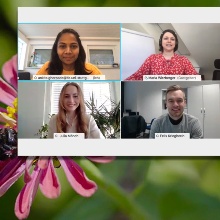Imagine an ordinary morning: You start the day with a cup of coffee, slip into a comfortable cotton shirt, and make yourself a delicious bowl of cereal with a lot of fresh fruit and nuts. If there weren’t any wild bees around however, you would have to do without all of this. There are more than 550 different species of wild bees known in Germany alone. More than half of them are on the Red List [de] of endangered animals, plants, and fungus species, plant communities, and biotope types, or have already become extinct. The consequences of this development are far more devastating than a limited selection of food on the breakfast table, as wild bees are characterized by their enormous pollination. Therefore, the diversity of our ecosystem depends significantly on their work.
Nevertheless, there is still a lack of social awareness about the problem, since these "wild sisters" of the familiar honeybees are relatively unknown and underestimated creatures in terms of their diversity and importance. A research team from Chemnitz University of Technology and the University of Stuttgart wants to change that – and thus, is developing the "BeeLife" app. The project is funded by the German Federal Environmental Foundation (DBU). The app is expected to be publicly available in 2023.
Idea for app sparked by master's seminar at Chemnitz University of Technology
"BeeLife" invites students on a journey into the world of wild bees, combining hands on environmental action with virtual game elements. The goal of the project is to sensitize students at a young age to the dramatic consequences if wild bees were to become extinct. Moreover, “BeeLife” teaches children what each individual can do today to change that situation. "The initial spark for the project emerged in a master's seminar at the Institute for Media Research in the summer of 2018," reports Jun.-Prof. Dr. Maria Wirzberger, project leader of "BeeLife." Wirzberger was employed as a research assistant and lecturer at the Faculty of Humanities at Chemnitz University of Technology from 2015 to 2018, also earning her PhD in Psychology in Chemnitz. Since March 2020, she has been the head of the Department of Teaching and Learning with Intelligent Systems at the Institute of Educational Science at the University of Stuttgart.
“In the seminar, students of media and instructional psychology developed creative ideas for promoting environmental awareness with digital media,” Wirzberger continues. Julian Bornemeier, Sonia Kampel, Maria Goretti Alvarez Serrano, and Lisa Ullmann, students of this class, came up with the initial idea of “BeeLife.” Bornemeier and Kampel are currently working on their doctorates at the Chair of Media Psychology (headed by Prof. Dr. Peter Ohler) at Chemnitz University of Technology. This marked the start of an innovative project, designed to bring digital learning environments into the classroom.
Prof. Dr. Günter Daniel Rey, head of the Professorship of Psychology of Learning with Digital Media at the Institute for Media Research at Chemnitz University of Technology, supports the joint project with his long-standing expertise in research on digital media learning. Promoting young scientists is particularly important to him: "I am very happy to see many new faces through this joint project and to support young scientists to expand their qualifications." The interdisciplinary project team, which in addition to Wirzberger and Rey, includes their employees Ankita Ghorpade, Judith Baatz, Julia Mönch (University of Stuttgart), and Felix Krieglstein (Chemnitz University of Technology), bundles a variety of competencies that enrich the project from multiple perspectives. Through the interdisciplinary project team, expertise in psychology, information technology, software design, media research, artificial intelligence, cognitive research, biology, and teaching are brought together.
"BeeLife" combines real environmental actions with virtual elements of gaming
To the project team, it is important that the app fosters children's motivation and creates personal involvement by building empathy.
Findings from multimedia learning research are comprehensively incorporated into the project, for example, on pedagogical agents that accompany learning and provide feedback and support. In addition, the app is intended to spark children's curiosity and, through its design, encourage them to discover the secrets of the characters it contains - in line with the credo: "Learning should be fun!"
However, the app, which will be used in 5th and 6th grade, is not the only element of the project. “BeeLife” will be integrated into project workshops, inviting students to carry out environmental activities outdoors. For instance, “BeeLife” includes mini games, in which students learn how to build a proper bee hotel by using (un)suitable materials or which kinds of flowers are bee-friendly. In those project workshops, students get the opportunity to directly apply what they have learned in the mini games.
The requirements for the app were collected in a workshop with teachers and experts for wild bees. Based on the evaluation of those findings, the project team is currently working on a storyline. It includes diverse, biologically well-founded characters, such as the Garden Wool Bee Mani or the Mason Bee Mia, which will take users on a journey to discover their secrets.
Ankita Ghorpade is currently managing the technical implementation of the first prototype, which is the focus of the actual project stage. This process will be completed by the end of the year and this prototype will make its way into the classrooms of participating schools for a first test round in early 2022.
Read more about wild bee conservation
It's a win-win situation. With “BeeLife,” schools can expand their didactic toolbox with an innovative digital teaching method close to the children's everyday lives. At the same time, the tremendously important species of wild bees will receive much needed attention.
Jun.-Prof. Dr. Maria Wirzberger, Institute of Educational Science, phone +49 711 685-81176, e-mail




